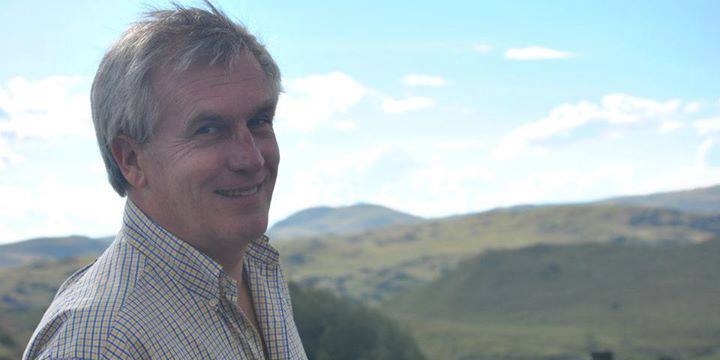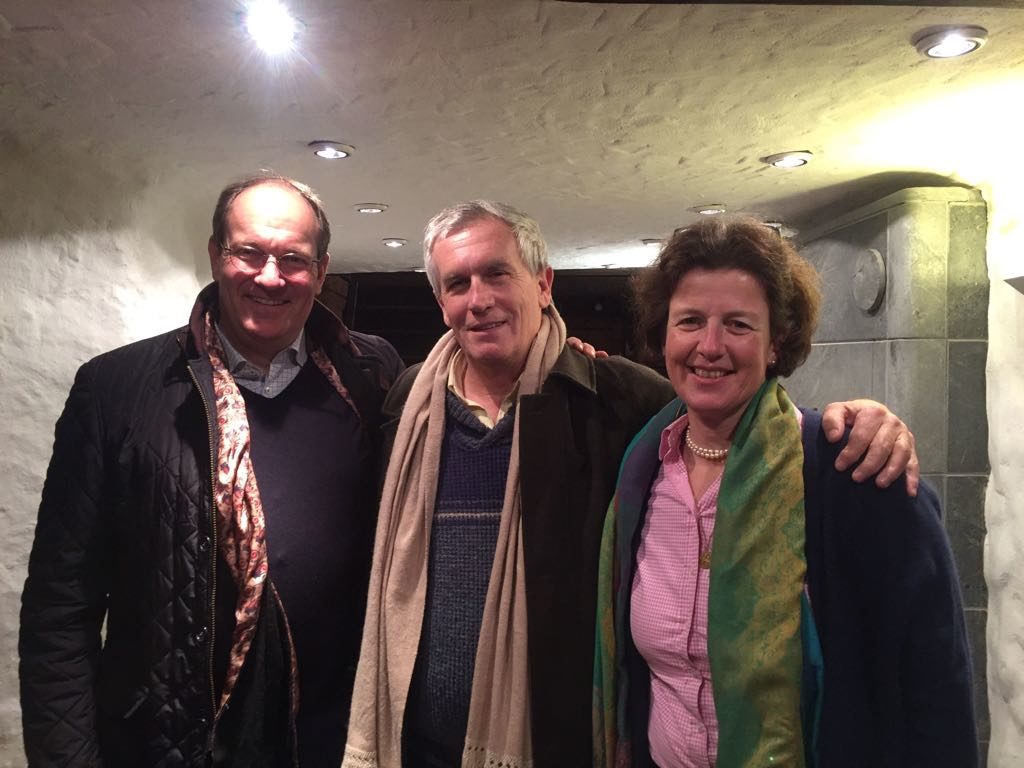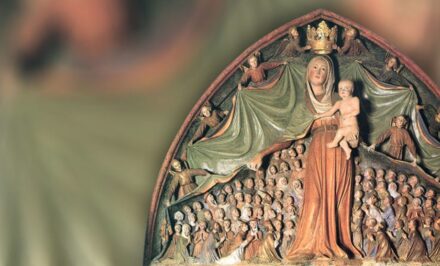ARGENTINA, Interview with Carlos Barrio y Lipperheide by Maria Fischer from schoenstatt.org •
Married to Maria José, a father of five, a lawyer, coach, the author of several books, a member of the Apostolic Schoenstatt Movement and the International Community of Schoenstatt Businessmen and Executives (CIEES), Carlos Barrio y Lipperheide, is no stranger to schoenstatt.org readers. Work and daily life — the “two environments where we spend the largest part of our life” (Fr. José Maria García in the prologue of the book “El Rosario de trabajo y de la vida [The Rosary of work and life]” by Carlos Barrio, p8) — have always been of great concern to this Argentinean. “Environments that today are considered as “peripheral,” distanced from his central message: the real presence of the Lord, the presence of his active, healing, saving, dignifying love and agent of communion,” (idem p9). We speak to Carlos Barrio about his new book and its potential for business people, executives, and workers. —

Carlos Barrio y Lipperheide
This book “Vivir la alegria en el trabajo” [Living joy at work] is not your first publication, but it is the most extensive book, not so? Where did you get the idea to write on this topic?

The book “Vivir la alegria en el trabajo” is undoubtedly, the biggest book I’ve written so far. It is based on my own experience of work. It developed from my need to give answers to the meaning of my work, in a very competitive and demanding environment, where human loyalties, and one imagines also God, are often absent.
Often in my working life, I asked myself about the meaning of my work and whether it is possible to live with joy in the midst of pressure, stress, and demands.
Little by little, I discovered that as I deepened my meaning of life, I also found greater meaning in everything I was doing. When I was able to discover my own originality and define my Personal Ideal, I was able to see the thread that guided my work, uniting both of these aspects. This allowed me to begin experiencing a deep joy in discovering that it was God who guides and shows me the path of his Providence.
The book proposes a practical way to develop various aspects that, together, allow us to live with joy at work.
I tried to make this an educational book for anyone who reads it. For this reason, at the end of each chapter, there are a series of questions for the reader to reflect personally on the theme of the chapter from their own experiences. After these questions, I included a meditation for the reader to stop and reflect a little, seeking to take this even further into his interior and experiences.
What was the initial reaction to your book and how can we get it?
The book was very well received in various places. The first thing I was told is that it is a topic that is very necessary today, given the amount of time we spend at work and the great demands it places on us.
The book in Spanish can be purchased at Schoenstatt bookshops in Argentina and on Amazon as an e-book (Kindle). You can also buy the hard copy via Amazon (Nueva Patris, ISBN-13: 978-9874635624).
There are several personal testimonies in this book and it is clear that it deals with a very important topic. What is the experience and the personal concern behind this book and its theme?
As I said before, it is a response to my own battle to find joy in my work. I feel that the joy is the fruit of the encounter with ourselves and with God. As Fr. Joseph Kentenich our founder said, “joy is always being sheltered by God at every moment. The Father loves me.” Without joy, our life loses its meaning.
As a journalist, I’m surprised and delighted that the longest chapter in the book is dedicated to communication. Why?
Good communication is key to a joyful life. We live in a world where we are a little bit autistic. It is difficult for us to leave our world and open up to others. We spend far too much time trying to have our say, closed in our own worlds. We have a deep inability to listen to others. We are always talking, and trying to impose our point of view in conversations. It is difficult for us to listen to what the other has to say and to open ourselves to new realities.
It is by listening that we open up to others and discover the richness that each person has.
I discovered the great number of layers that block out healthy listening, starting with our environment, the language we use, the emotion and body language that we display, without even knowing it ourselves.
I have also discovered that listening should go deeper, moving from what is said to feelings, needs, desires, and also include what is not said that might lie behind these aspects.
Finally, we have to develop an ear that is attentive to the goodness that each person carries within them. Each person has a message of life that they want to share, despite differences of the vision that each person might have.
In addition to listening, I have discovered the enormous difficulties we have in expressing ourselves to others, and how often we transfer our frustrations and mental paradigms in our messages.
From a different perspective, we have to discover that our communication, in addition to being based on the rhythm of listening and speaking, should develop communicational attitudes that allow us to free ourselves from various obstacles and chains to which we subject others, so that we can convey motivation and joy. In this way, our communication will be complete, allowing us to embody pathways of joy.
The book has many quotations from Fr. Joseph Kentenich and uses his pedagogy in the world of work. How did you become aware of the compatibility of Fr. Kentenich’s message and the world of work today?
I think that today’s world of work is somewhat similar to what Fr. Kentenich experienced in his time. Today we have new, more virtual realities, but Joseph Kentenich also experienced an era that, using today’s language, we can describe as “liquid,” a term coined by the sociologist Zygmunt Baumante, and of massification under the influence of Nazism. Today we have new phenomena of massification that are more virtual but which we can liken to what people experienced in Fr. Kentenich’s generation.
Similarly, the phenomenon of “mechanistic thinking” that Kentenich also described still exists today, in an even more intense form than he would have experienced. We constantly see this mechanistic thinking in the world of work.
The ideal of an organic world that Kentenich laid out is still valid, given that modern man still completely separates the working and private worlds, which the world sets out in a rational way and which we end up experiencing in practice.
Another key personality in the book is your countryman, Enrique Shaw. What role does he have for executives and business people today?
The Argentinean businessman Enrique Shaw was a very practical example of someone who embodied Christian ideals in the business sector. Pope Francis, who presented his case for canonization when he was still the Archbishop of Buenos Aires, discovered in him a model businessman, worthy of being emulated, for his organic coherence and living his faith in the business world.
One of Enrique Shaw’s principle virtues was to listen to the voice of God throughout his life. He allowed himself to be led by God. He knew how to live what we as Schoenstatters call “practical faith in Divine Providence.” A concrete example of this was his radical change of job. After being in the Navy for ten years, from 1935 to 1945, he decided to dedicate himself to the world of business, after having first suffered a deep crisis of searching for his path.
He also had the great virtue of having the “smell of the sheep,” as Pope Francis asks of us. His closeness to the employees in the factory where he worked and with other business people with whom he had dealings was a living testimony of an organic life. In this regard, he has many similarities with Joseph Kentenich.
No less significant was his testimony of the way he faced his terminal illness that took him to the presence of the Father at a young age. He was born in 1921 and died in 1962, which means he was 41 when he died.
It is worthwhile to recall some of his statements on the journey to his death. Already bed ridden, he received blood transfusions from 260 workers at the Rigolleau factory, where he was the general director, who spontaneously donated blood. When he was told of this, he asked a delegation to come and see him, and said to them:
“Sorry if I am unclear because my tongue has stiffened as if I were a polio sufferer. But I did not want to omit thanking you for everything you have done for me by giving your blood for the transfusions they are giving me. I want to say that now, almost all of the blood that runs in my blood is labourer blood. More than ever, I identify with you, who I have always cared about and considered not as simple executors, but also as executives.”
It is a notable summary of the organic integration of his life. Finally, before he died he turned to his children from his hospital bed and told them:
“Before I bragged about giving and always giving, but now it’s my turn to receive everything: food, blood, medicine, the care of my family, my doctors, nurses, my father’s money to pay the nurses, and this makes me more humble, because I experienced a certain pride in giving. In contrast, receiving so many things make me aware of the many people who care for me, and also make me understand how little I gave God in comparison with how much I received from Him during my life.
As you can see, he was a saint.
His testimony so deeply impressed the International Community of Schoenstatt Businessmen and Executives (CIEES) that the congress in Peru last year considered making him the patron of CIEES.
This would be very valuable, whenever we discover Kentenich roots in his words and actions. Enrique Shaw’s testimony should make us live Schoenstatt even more deeply, to discover our Schoenstatt charism in him. He should be a way toward our father and founder. We cannot lose sight of this. However, this is not a path we should continue to follow at the risk of losing sight of the purpose of CIEES. If we only see Enrique Shaw’s virtues without getting to Kentenich, we run the risk of losing our own identity and treasure. The Schoenstatt message for the world today and the future cannot be replaced by the exemplary and holy life of Enrique Shaw. Shaw must be our inspiration to deepen our own identity.
In your book there is a chapter about the “tree with leaves of success.” What leaf have you placed on your personal tree after this book saw the light of day?
Writing this book was a very difficult goal, given how little free time I have. So the leaf on my tree is having achieved the writing and editing of this book.
The second leaf was when the International Kentenich Academy for executives (IKAF), that is, CIEES in Germany and Switzerland asked for permission to translate the book into German, which you, Maria, did and which gave me great joy.
Yes, it was a very challenging and beautiful task, also because it coincided with a very difficult period in my working life. I can say this book has great potential and poses the question about whether you really have joy in your work, and if you don’t, why? I decided to leave this job and find something new a few days before finishing the translation…These were my two leaves of success.
I saw the request from IKAF as a sign that the theme set out in the book is current and responds to a human need in the contemporary working world.
The Grauert couple (who took up the initiative to translate the book into German) told me that they are finalising the last details and believe that it will be available as an e-book on Amazon (Kindle) in May.
Personally, my consulting company is offering workshops for people who work in companies, where I help them to discover this search for joy in work.
When I have run several workshops, I’ll b able to tell you if I have a third leaf on my tree. But I haven’t got there yet.
Does this book also have meaning for people who are simply employees, labourers, or workers?
My desire is that this book will also be meaningful for ordinary people and workers. Even though it has some theoretical elements that may seem more tedious and heavy, I have tried to make it concrete in the life of each person by means of questions and the meditation at the end of each chapter. I hope I have managed to achieve this!
What is your wish for this book and your message?
I hope that this book can help others to live with more joy in the world of work. I am convinced that the path I am proposing is the one that can help us to achieve it. There are many others, but this is the path I have discovered through my working experiences over the course of 35 years working in various national and international companies. The book represents my journey, the path I took and because of which, on many occasions, I had to suffer desolation and frustration until I discovered the path that brought me to joy.
For this reason, the book ends with the Work Song [link in Spanish only] which I composed, inspired by our father and founder’s Home Song. I believe that this Work Song is a summary of hope to achieve the goal of becoming the New Person that Kentenich speaks about. Truly, Joseph Kentenich is the great inspiration and the main source of my book. I am very happy that it will be available during the year we are celebrating the Father Kentenich year.
Thank you very much, Carlos, for making the time for this interview.
It has been a pleasure, Maria, to answer your questions.
 Carlos Barrio y Lipperheide
Carlos Barrio y Lipperheide
Vivir la Alegría en el trabajo.
Editorial Patris, Córdoba, Argentina, 2017, 244 p.
ISBN: 978-987-46356-2-4
E-Book (Amazon Kindle)
Carlos Barrio y Lipperheide
Vivir la Alegría en el trabajo.
ASIN: B077WJ586J
Sale through Nueva Patris
Original: English, 21 March. Translation: Sarah-Leah Pimentel, Cape Town, South Africa















